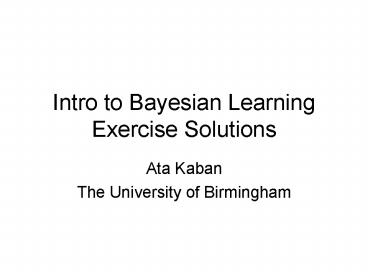Intro to Bayesian Learning Exercise Solutions - PowerPoint PPT Presentation
1 / 5
Title:
Intro to Bayesian Learning Exercise Solutions
Description:
... a maximum likelihood versus a maximum a posteriori hypothesis estimation method? ... The answer at b) is based on the maximum a posteriori estimate, as we have ... – PowerPoint PPT presentation
Number of Views:32
Avg rating:3.0/5.0
Title: Intro to Bayesian Learning Exercise Solutions
1
Intro to Bayesian LearningExercise Solutions
- Ata Kaban
- The University of Birmingham
2
- You are to be tested for a disease that has
prevalence in the population of 1 in 1000. The
lab test used is not always perfect It has a
false-positive rate of 1. A false-positive
result is when the test is positive, although
the disease is not present. The false negative
rate of the test is zero. A false negative is
when the test result is negative while in fact
the disease is present. - a) If you are tested and you get a positive
result, what is the probability that you actually
have the disease? - b) Under the conditions in the previous question,
is it more probable that you have the disease or
that you dont? - c) Would the answers to a) and / or b) differ if
you use a maximum likelihood versus a maximum a
posteriori hypothesis estimation method? Comment
on your answer.
3
- ANSWER a) We have two binary variables, A and B.
A is the outcome of the test, B is the
presence/absence of the disease. We need to
compute P(B1A1). We use Bayes theorem - Now the required quantities are known from the
problem. These are the following - P(A1B1)1, i.e. true positives
- P(B1)1/1000, i.e. prevalence
- P(A1B0)0.01, i.e. false positives
- P(B0)1-1/1000
- Replacing, we have
4
- b) Under the conditions in the previous question,
is it more probable that you have the disease or
that you dont? - ANSWER
- P(B0A1)1-P(B1A1)1-0.09099.
- So clearly it is more probable that the disease
is not present.
5
- c) Would the answers to a) and / or b) differ if
you use a maximum likelihood versus a maximum a
posteriori hypothesis estimation method? Comment
on your answer. - ANSWER
- ML maximises P(Dh) w.r.t. h, whereas MAP
maximises P(hD). So MAP includes prior knowledge
about the hypothesis, as P(hD) is in fact
proportional to P(Dh)P(h). This is a good
example where the importance and influence of
prior knowledge is evident. - The answer at b) is based on the maximum a
posteriori estimate, as we have included prior
knowledge in the form of prevalence of the
disease. If that would not been taken into
account, i.e. both P(B1)0.5 and P(B0)0.5 is
considered than the hypothesis estimate would be
the maximum likelihood one. In that case the
presence of the disease would come out be more
probable than the absence of it. This is an
example of how prior knowledge can influence the
Bayesian decisions. However, more data should be
collected in order to produce a more reliable
estimate.































